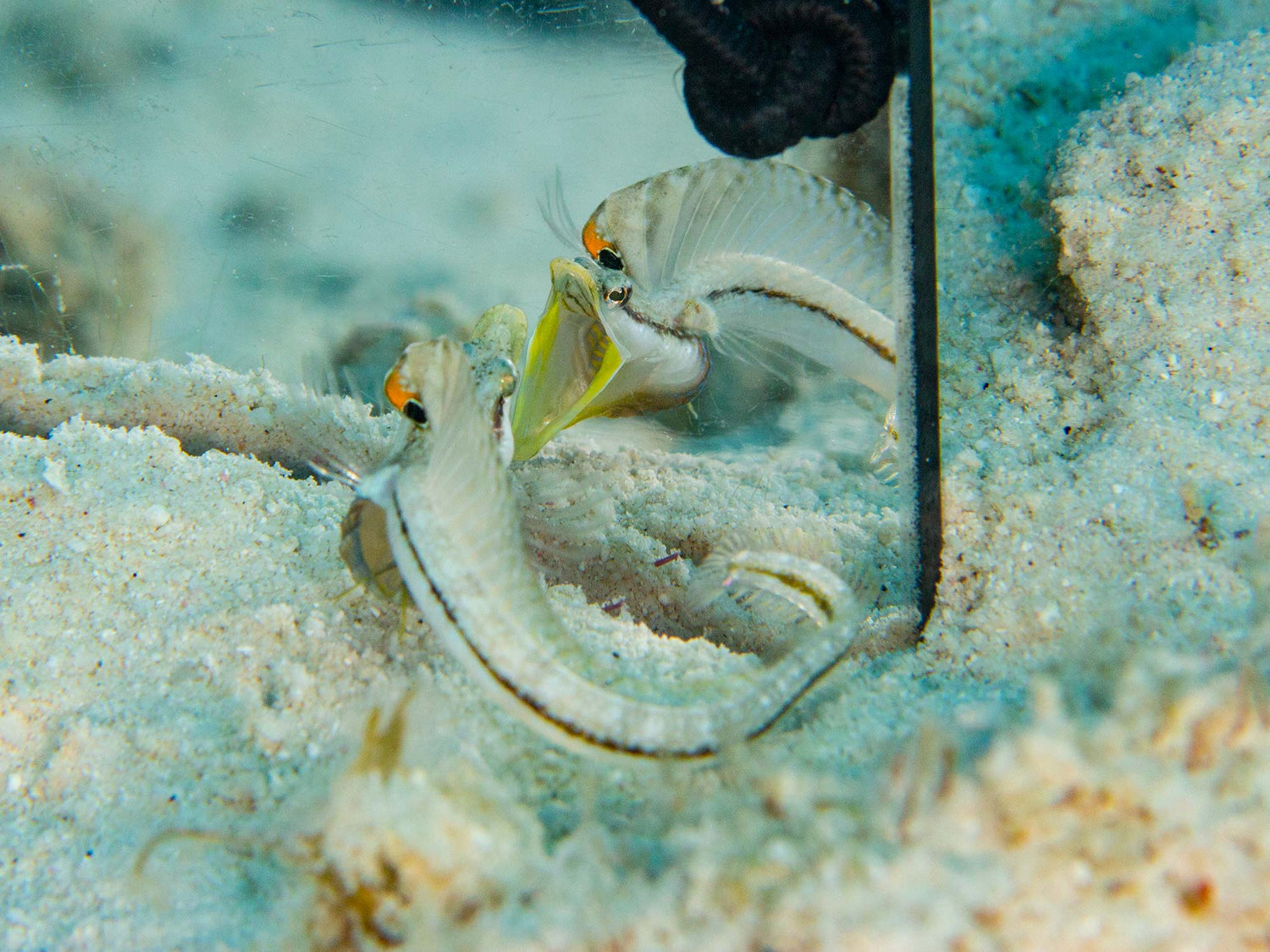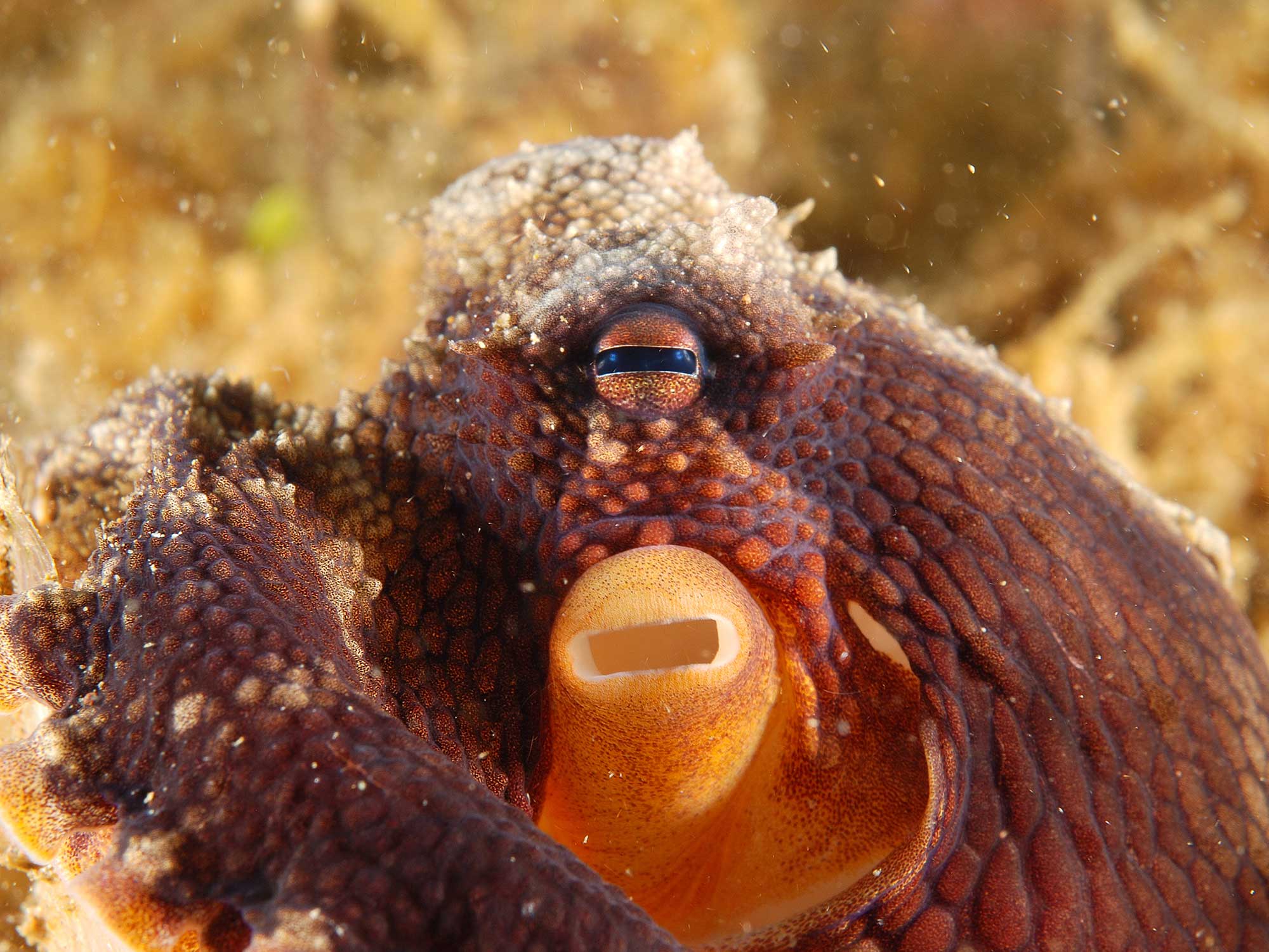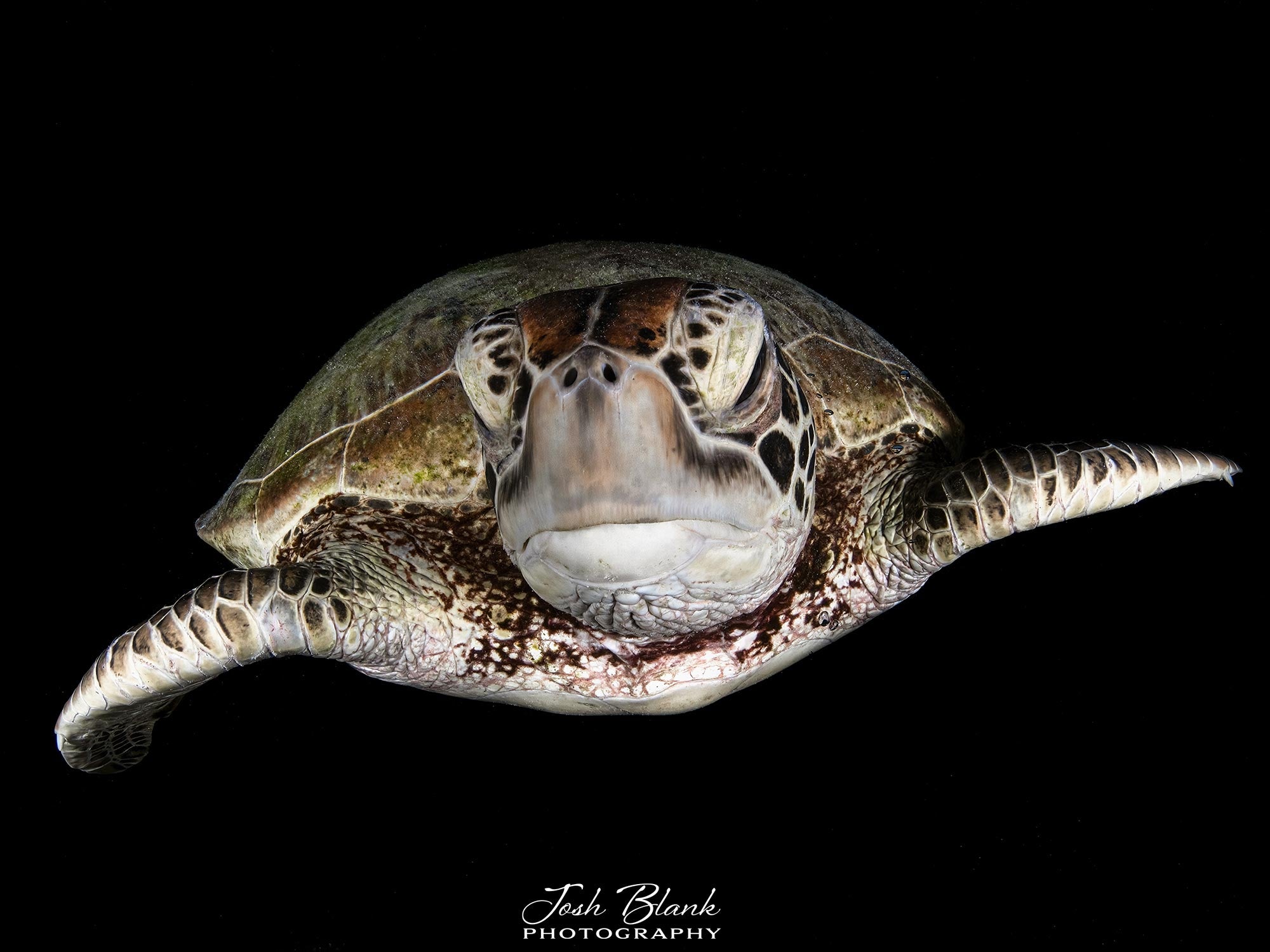By Douglas Klug
All images © Douglas Klug
Let’s face it, the underwater world can be a harsh place. As divers, we embrace underwater beauty and overlook the fact that just about everything on any reef anywhere eats or will be eaten by something else on that same reef. This harshness, however, can lead to striking marine life behavior images for the underwater photographer. With a little critter knowledge, some planning, and the right tools, an underwater photographer can capture predictable marine life behaviors that are a step up from an ordinary fish portrait.


In the two images above, you can see the difference between the “portrait” shot of an orangethroat pikeblenny and the “display” shot brought out with some mirror-manipulation. © 2022 Douglas Klug
Macro Manipulation
You can generate reflections under water using a mirror, sunlight, a modeling light, or even a snoot. Most of the time, you’re going to be shooting macro or at least close-up with small animals. Unless you plan on swimming around with a three-foot-wide mirror, it’s unlikely you’ll manipulate large creatures into a territorial display. Since any display in the natural world could be a precursor to “attack,” its probably safer to work with little creatures than ones that could seriously hurt you or your buddy. The bonus to this type of shot is that you can use any type of camera and shoot stills or even video.
Critter Knowledge
Here's where the “critter knowledge” comes in. If you don’t know, a divemaster, guide, or even a local diver can help clue you in. You can try these techniques in oceans all around the world, as long as you’re in an area where you can work without damaging any reef. Many of the fish I shoot in this manner live on a sand or gravel seafloor, but with good diving skills you can work in other environments.
The orangethroat pikeblenny is a favorite subject for Eastern Pacific underwater macro photographers from Mexico up to Southern California. Males are fiercely territorial over the space around them and will not tolerate another male pikeblenny getting too close. To get these shots, I place a small mirror gently into the sand or gravel a few inches from the fish and just wait to see if it notices its own reflection. By showing the fish its own reflection, I can sometimes witness and capture the territorial display.


Once the mirror comes out, things can get a little crazy if the fish is particularly zealous about defending its turf. © 2022 Douglas Klug
You can see that even though the mirror is worn and not “super reflective” it works well enough to draw in the pikeblenny and encourage it to issue a challenge display. This isn’t just a cold-water phenomenon. Different species of pikeblennies occur around the world but have the same behavior.
Make Do Without a Mirror
Sometimes, your dome port itself does the job. In the cool waters of Southern California, the fish with the “best name ever” inhabits abandoned shells on the bottom. Fiercely territorial with a head the size of your fist, male sarcastic fringeheads will rush out to challenge any other male of the same species that they see, even if it’s their own reflection in an underwater photographer’s dome port.

Here, I just relied on sunlight to show the fish its own reflection in my Ikelite 6” dome port. © 2022 Douglas Klug
Even the tiny yellowfin fringehead, another Eastern Pacific fish that’s smaller than your little finger, will flare up and put on a display in front of a mirror. In these images, I kept the mirror out of the frame but still got the desired results.


Here’s a yellowfin fringehead that gave me a display while I was shooting it with a snoot. I wasn’t originally trying for a “display” shot, but the spotting light from the snoot lit up the fish enough that it could see its reflection in my Ikelite flat macro port.

I watched the display unfold through my viewfinder and waited for it to culminate to capture this image. © 2022 Douglas Klug
The iconic garibaldi is an Eastern Pacific damselfish about the size of a dinner plate that is somewhat infamous for the number of dome ports that have suffered scratches from its attacks on its own reflection. The males are defensive of their nesting area and will drive off every other male garibaldi (and just about anything else) that comes too close.

This image was shot by flipping on my modeling light and hovering over the male garibaldi’s section of the reef. When the fish got close, the light let it see its own reflection in my Ikelite dome port and the challenge began. © 2022 Douglas Klug
Ethics 101
Always consider the difference between manipulation and harassment when working with sea life like this. We can manipulate to educate through our images, but we should never harass. Let the critter decide if it’s going to react to its reflection. Never chase and don’t bump or prod the animal with a reef-rod or even the mirror. Take care that the mirror is stable if you’re not holding it, so that surge doesn’t cause it to fall on the subject you're shooting. Don’t let a subject injure itself in the display. With pikeblennies, once they get to the point where they are making contact with the mirror, I remove it and find another subject. Remember that the territorial display costs energy, and the fish must find its next meal to replenish that energy. If a subject doesn’t react, move on. It could be that it's just not up to the display. Fish like pikeblennies, fringeheads, and damselfish tend to live in groups over the same general area. Don’t spend all your efforts (and flashes) on one poor fish. If there’s one, there’s more. After a few minutes (and tries) on one fish, give that one a rest and find a different subject.

Douglas Klug is a SCUBA diving instructor and underwater photographer in Santa Barbara, CA. Doug has been diving California’s Channel Islands for over 30 years and has logged thousands of dives in the kelp forests around Anacapa, Santa Cruz, Santa Rosa, and San Miguel Island. Doug specializes in underwater photography within the kelp forest environment. Doug’s photo-essays have been published in print world-wide, including articles in California Diving News, DAN Alert Diver, and Dive Training. Doug’s images have been used in numerous print and digital formats including use by the US National Park Service, US National Marine Sanctuary, and the Monterey Bay Aquarium, Google, and Microsoft. Doug even does live talks on underwater photography for dive clubs and museums in Southern California. In addition to underwater photography and other SCUBA courses, Doug even teaches a SCUBA course on Southern California Nudibranch Identification for divers who want to learn the names of some of the coolest “macro” critters on kelp forest reefs.
Want the easy way to improve your underwater photography? Sign up for our weekly newsletter for articles and videos directly in your inbox every Friday:
Additional Reading
Customer Photos | Douglas Klug in California's Kelp Forests and Beyond
Garibaldi Underwater Camera Settings and Technique
Kelp Forest Underwater Camera Settings and Technique
An Insider's Guide to Shore Diving Catalina Island
Nikon Z6 II or Canon R6 Housing? Back in the Water in Catalina [VIDEO]
The Next Generation of Professional Underwater Strobes













